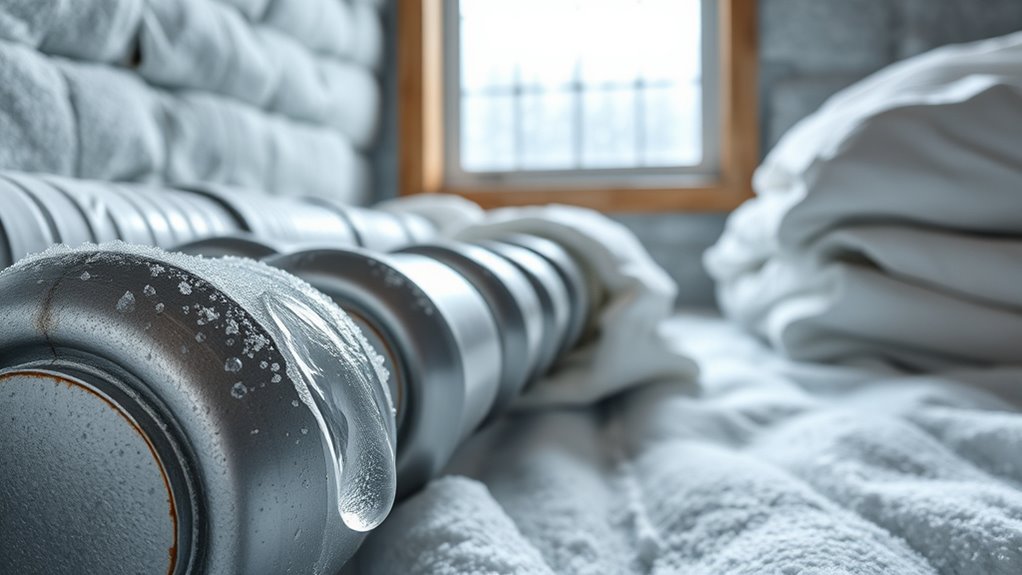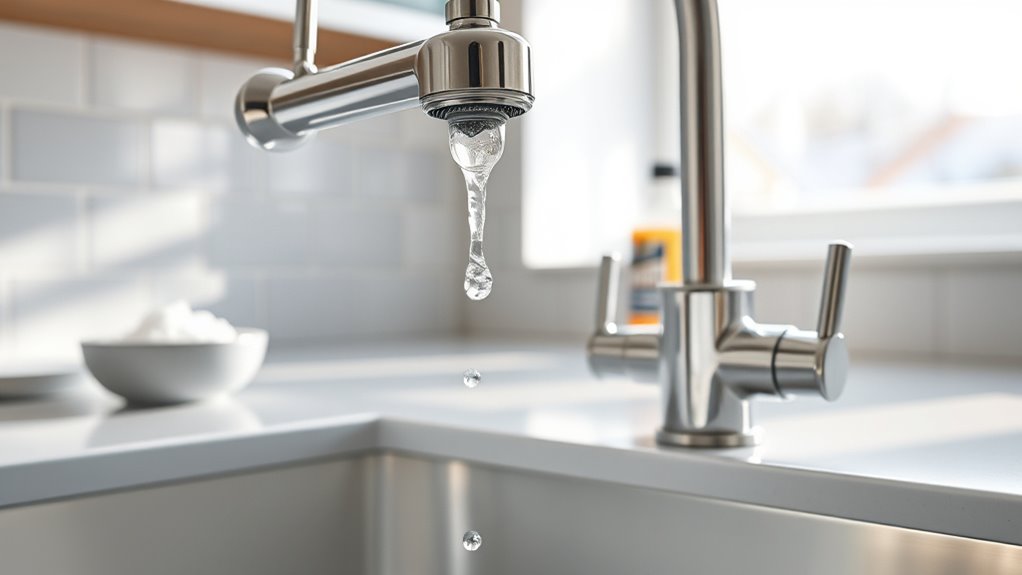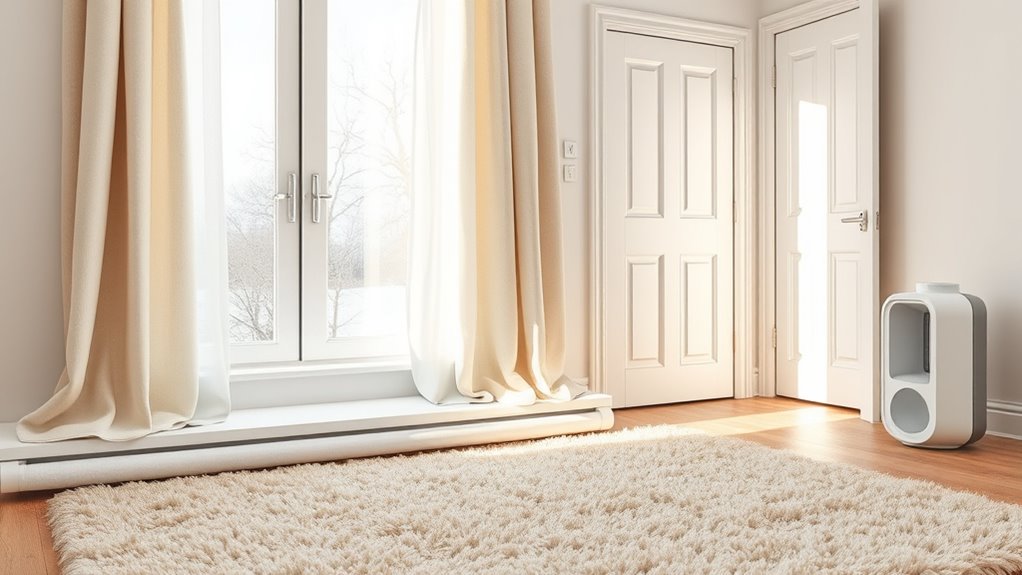To prevent pipes from freezing without relying on heat, homeowners should focus on insulation and circulation. Insulating exposed pipes with foam sleeves or fiberglass wrap is essential. Opening cabinet doors allows warm air to circulate, while dripping faucets creates a steady flow that prevents freezing. Using heat tape can also provide warmth directly to vulnerable pipes. Monitoring weather conditions helps anticipate risks. For further practical solutions, exploring additional protective measures can enhance pipe safety during winter.
Understanding Pipe Freezing Risks

How can homeowners effectively safeguard their plumbing systems against the harsh effects of winter? Understanding the risks associated with pipe freezing is vital in this regard.
When temperatures plummet, water within pipes can freeze, leading to blockages and potential bursts. This risk is heightened in areas with poor insulation, such as basements and attics. Additionally, pipes located on exterior walls are particularly vulnerable, as they are exposed to colder air.
Homeowners should be aware that even minor cracks in a building’s exterior can allow frigid air to reach these pipes. Regular maintenance is essential; checking for leaks and ensuring proper sealing can mitigate risks.
Taking proactive measures can help prevent costly repairs and safeguard the integrity of the plumbing system during winter months.
Insulating Exposed Pipes
While many homeowners may overlook the importance of insulating exposed pipes, doing so is crucial for preventing freezing during the winter months.
Exposed pipes, especially those located in unheated areas like basements, attics, and crawl spaces, are particularly vulnerable to extreme cold. Insulation materials such as foam pipe sleeves, fiberglass wrap, or heat tape can greatly reduce the risk of frost forming on these pipes.
Homeowners should make sure that all accessible pipes are covered, paying special attention to joints and fittings. Additionally, sealing any gaps or cracks in walls or foundations that might expose pipes to cold air will further enhance protection.
Keeping Cabinet Doors Open
Keeping cabinet doors open can greatly enhance the flow of warm air into enclosed spaces, particularly around plumbing fixtures.
This simple action helps maintain a stable temperature, reducing the risk of frozen pipes. Additionally, it serves to protect essential plumbing components from the harsh effects of cold weather.
Allow Warm Air Flow
To prevent pipes from freezing, allowing warm air to flow freely is essential, particularly in enclosed spaces such as cabinets under sinks. Keeping cabinet doors open encourages air circulation, ensuring that warmer air from heated rooms reaches the pipes. This simple action can greatly reduce the risk of freezing, especially during extreme cold spells.
| Action | Benefit |
|---|---|
| Open cabinet doors | Enhances airflow |
| Use space heaters | Directs warm air |
| Insulate pipes | Retains heat |
| Allow heat from rooms | Warms surrounding area |
| Check for drafts | Minimizes cold air entry |
Protect Plumbing Fixtures
Ensuring that plumbing fixtures are adequately protected is essential in preventing frozen pipes. One effective method is to keep cabinet doors open, particularly those under sinks where plumbing is often located. This allows warm air from the home to circulate around the pipes, reducing the risk of freezing.
Homeowners should focus on areas where plumbing is situated against exterior walls, as these are more susceptible to cold temperatures. During particularly frigid nights, it is advisable to leave the cabinet doors open to maintain a consistent temperature around the pipes.
Additionally, homeowners can place a small heater nearby, ensuring it does not pose a fire risk. By implementing these simple strategies, one can considerably mitigate the chances of plumbing issues during winter months.
Dripping Faucets Technique

The dripping faucets technique serves as an effective strategy to prevent pipes from freezing during cold weather.
By allowing a small, steady stream of water to flow, homeowners can alleviate pressure within the pipes and reduce the risk of ice formation.
Selecting the appropriate faucets for this method is essential to guarantee consistent and effective water flow.
Benefits of Dripping Faucets
A simple yet effective method to prevent pipes from freezing involves allowing faucets to drip slowly. This technique helps maintain a continuous flow of water, reducing the likelihood of ice formation within the pipes.
As water moves, it creates friction, which generates heat and prevents freezing. Additionally, dripping faucets can relieve pressure that builds up in the plumbing system, minimizing the risk of bursts in frozen pipes.
This method is particularly beneficial in extreme cold conditions, where stagnant water is more susceptible to freezing. Implementing this strategy is cost-effective and requires minimal effort, making it an accessible solution for homeowners looking to protect their plumbing during winter months.
Proper Faucet Selection
Selecting the right faucet is vital for effectively implementing the dripping faucets technique to prevent pipe freezing. A faucet that allows for a steady, controlled drip can greatly reduce the risk of frozen pipes in cold weather.
Ideally, homeowners should choose faucets that are designed for outdoor usage, as these can withstand harsher winter conditions. It is advisable to select faucets with a wide opening to facilitate a consistent drip rate.
Additionally, verifying that the faucet is located at the farthest point from the house’s main water supply can optimize the effectiveness of this method. Regular maintenance checks are also essential to guarantee that the faucet operates correctly, allowing for continuous dripping during extreme cold temperatures.
Using Heat Tape
When temperatures plummet, heat tape emerges as an effective solution for preventing pipes from freezing. This electrical tape is designed to provide direct warmth to plumbing lines, ensuring they remain at a safe temperature during frigid conditions. It is easy to install, making it a popular choice among homeowners and businesses alike.
| Type of Heat Tape | Advantages | Installation Tips |
|---|---|---|
| Self-Regulating | Adjusts temperature automatically | Follow manufacturer guidelines |
| Constant Wattage | Provides consistent heating | Use with insulation for best results |
| Thermostatically Controlled | Energy efficient | Install on dry surfaces only |
Sealing Cracks and Openings
To effectively prevent pipes from freezing, sealing cracks and openings in the home is crucial, as cold air can easily infiltrate and lower indoor temperatures.
Homeowners should assess areas where air may enter and address them promptly.
Key areas to inspect include:
- Windows and Doors: Check for gaps around frames and use weather stripping or caulk to seal them.
- Foundation and Walls: Inspect the foundation for cracks and fill them with appropriate sealant or foam insulation.
- Attic and Basement: Look for openings where pipes enter or exit the home and make sure they are sealed with insulation or expanding foam.
Maintaining Steady Indoor Temperatures

Sealing cracks and openings helps create a more stable environment inside the home, which is essential for maintaining steady indoor temperatures. This stability is vital during winter months, as fluctuations can lead to increased energy consumption and potential pipe freezing.
Homeowners should consider insulating exposed pipes and areas prone to drafts, such as attics and basements. Utilizing thermal curtains can also aid in maintaining warmth by preventing heat loss through windows.
Regularly monitoring indoor temperatures allows for timely adjustments, ensuring the home remains at a consistent level. Additionally, strategically placing furniture can help block drafts and promote even heat distribution throughout the space.
Together, these measures contribute to a warmer environment, reducing the risk of freezing pipes.
Utilizing Warm Water Sources
Utilizing warm water sources can greatly aid in preventing pipe freezing during cold weather.
Effective insulation of pipes helps maintain a consistent temperature, while allowing faucets to drip can keep water moving and reduce the risk of freezing.
Together, these strategies form a proactive approach to safeguarding plumbing systems in frigid conditions.
Insulating Pipes Effectively
While many homeowners focus on traditional insulation methods to protect their plumbing, utilizing warm water sources can also play an essential role in preventing pipes from freezing.
By strategically incorporating warmth into the plumbing system, homeowners can enhance the effectiveness of insulation.
Here are three effective strategies for leveraging warm water sources:
- Circulate Warm Water: Keeping warm water circulating through pipes can maintain a consistent temperature, reducing the risk of freezing.
- Insulating Hot Water Lines: Insulating hot water pipes helps retain heat, which can indirectly warm nearby cold water pipes.
- Using Radiant Heat: Installing heating cables or mats around vulnerable pipes can provide additional warmth, creating a protective barrier against extreme cold.
These methods can greatly contribute to safeguarding plumbing during winter months.
Dripping Faucets Strategy
One effective method to prevent pipes from freezing during cold weather is the strategy of dripping faucets. This technique involves allowing a small stream of warm water to flow continuously from the faucet, which helps keep the water in the pipes moving. By maintaining this flow, the risk of freezing is greatly reduced.
| Faucet Type | Recommended Drip Rate | Benefits |
|---|---|---|
| Kitchen Faucet | Slow drip | Maintains water movement |
| Bathroom Faucet | Steady stream | Prevents pressure build-up |
| Utility Sink | Light trickle | Reduces freezing risk |
| Outdoor Faucet | Drip on warm days | Protects exposed pipes |
Implementing this strategy can be a simple yet effective approach to safeguarding plumbing during harsh winter conditions.
Opening Interior Doors
How can opening interior doors help prevent pipes from freezing? This simple yet effective strategy enhances airflow and helps maintain a more consistent temperature throughout a home.
When interior doors are left open, warmer air can circulate more freely, reducing the risk of cold spots where pipes are located.
Here are three benefits of this approach:
- Improved Air Circulation: By allowing warm air to reach enclosed spaces, the temperature around pipes rises, minimizing freezing risk.
- Reduced Cold Spots: Opening doors helps eliminate pockets of cold air that can form in rooms, particularly those that are less frequently used.
- Increased Heat Distribution: This practice aids in balancing heat distribution, ensuring that areas with vulnerable plumbing receive adequate warmth.
Keeping Garage Doors Closed
Keeping garage doors closed is essential for preventing pipes from freezing, as it minimizes the cold air that can infiltrate the space. Unattended openings allow frigid temperatures to seep in, increasing the risk of frozen pipes, particularly those located in exterior walls or near uninsulated areas.
Additionally, closing garage doors helps maintain a more stable temperature within the garage, providing a buffer against the harsh outdoor conditions. Homeowners should also guarantee that any gaps around the door are sealed, as drafts can further compromise the warmth inside.
Regular inspection of the garage door for proper sealing and functionality can notably contribute to a safer environment for plumbing systems during winter months, ultimately reducing the likelihood of costly repairs.
Using a Space Heater
Utilizing a space heater can effectively combat the frigid temperatures that lead to frozen pipes in vulnerable areas of a home. By strategically placing a space heater in critical zones, homeowners can maintain a warmer environment and protect their plumbing.
When employing a space heater, consider the following:
- Location: Position the heater near exposed pipes, such as those in basements or crawl spaces, to maximize warmth.
- Safety: Verify the heater is placed on a flat, stable surface away from flammable materials to prevent fire hazards.
- Monitoring: Regularly check the heater’s operation and temperature settings to confirm it is functioning properly throughout the coldest months.
Implementing these practices can help safeguard plumbing systems from the dangers of freezing.
Moving Water With a Pump
When considering how to prevent pipes from freezing, utilizing a pump can be an effective solution.
An overview of various pump types and their specific applications will provide clarity on the best options available.
Additionally, installation tips and tricks can enhance efficiency and reliability in maintaining water flow during cold weather.
Pump Types Overview
Understanding the various types of pumps is essential for effectively moving water, especially in situations where freezing pipes can lead to significant damage.
Different pump types serve unique purposes and can be selected based on specific needs. Here are three common types of pumps:
- Centrifugal Pumps: These pumps utilize rotational energy to move water, making them suitable for high-flow applications.
- Submersible Pumps: Designed to operate submerged in water, these pumps are ideal for draining or transferring water from deep sources.
- Diaphragm Pumps: These pumps use a flexible diaphragm to create pressure differences, allowing for precise control of fluid movement, particularly in low-flow scenarios.
Each type plays a critical role in maintaining water flow and preventing pipe freezes during colder months.
Installation Tips & Tricks
Proper installation is vital for the effective operation of pumps, especially in preventing water from freezing in pipes during cold weather. Making sure that a pump is installed correctly can maintain water movement, and therefore reducing the risk of freezing. Key considerations include selecting the appropriate pump type, making sure proper alignment, and securing all connections tightly. Additionally, maintaining an adequate water flow rate is essential.
| Installation Tip | Description |
|---|---|
| Choose the Right Pump | Select based on flow and pressure |
| Secure Connections | Tighten all fittings to prevent leaks |
| Proper Alignment | Make certain the pump is level |
| Maintain Flow Rate | Adjust settings for steady flow |
Creating Circulation in Plumbing
Ensuring adequate circulation in plumbing systems is essential for preventing pipes from freezing during cold weather. A well-circulated system maintains a consistent flow of water, reducing the risk of stagnant areas that can freeze.
Homeowners can implement several strategies to enhance circulation:
- Open faucets slightly: Allowing a trickle of water to flow can prevent freezing by keeping water moving within the pipes.
- Utilize ceiling fans: Running ceiling fans in reverse can help circulate warm air throughout the space, indirectly aiding the plumbing system.
- Keep interior doors open: This encourages airflow between rooms, helping to maintain overall warmth and preventing cold spots near plumbing fixtures.
These measures collectively contribute to a more resilient plumbing system during winter’s harsh conditions.
Installing Pipe Insulation Sleeves
Installing pipe insulation sleeves offers a practical solution to prevent pipes from freezing in frigid temperatures.
These sleeves, typically made from materials like foam or fiberglass, wrap around exposed pipes to provide a thermal barrier against cold air. Their installation is straightforward and can be completed with minimal tools.
By creating a layer of insulation, they help maintain the temperature of the water inside the pipes, reducing the risk of freezing. Additionally, pipe insulation sleeves can be found in various sizes and thicknesses, allowing homeowners to select the most suitable option for their specific needs.
This cost-effective measure contributes considerably to energy efficiency, as it helps maintain consistent water temperatures throughout the winter months.
Monitoring Weather Conditions
How can homeowners effectively safeguard their plumbing during winter months?
Monitoring weather conditions is vital for preventing frozen pipes. Homeowners should stay informed about temperature fluctuations and severe weather warnings. By doing so, they can take proactive measures to protect their plumbing systems.
Here are three key strategies to take into account:
- Check Local Forecasts: Regularly review weather forecasts, focusing on nighttime lows that could drop below freezing.
- Set Up Alerts: Utilize weather apps or services that send notifications about temperature drops, allowing for timely action.
- Inspect Temperature Trends: Be aware of sustained cold spells, which increase the risk of freezing pipes, prompting immediate insulation measures.
Conclusion
In the battle against pipe freezing, homeowners can employ a variety of practical strategies to safeguard their plumbing systems. By insulating exposed pipes, allowing faucets to drip, and utilizing heat tape, they can create a fortress against the cold. Just as a wise gardener tends to fragile seedlings during winter, so too must one nurture their home’s plumbing with care and foresight. Vigilance and preparation can guarantee that pipes remain unfrozen, even in the harshest winter conditions.

I’m Allen Kim, the chief editor of plumbinginto. I am a mid level plumber and assign to an local firm over 4 years of experience. During the working period, most of my experience is related to the house plumbing. I learned about the thing, when working with most experienced people in this sector, one must be as good as the inspector or better with knowledge of the project as well as the practical aspects of plumbing industry.